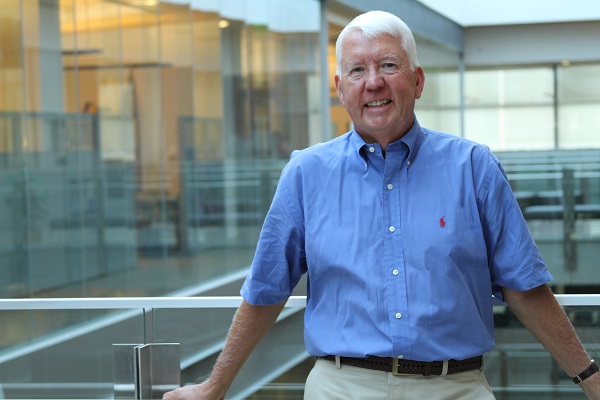Arizona State University Biodesign Institute researcher Charles Arntzen has been chosen as the No. 1 honoree among Fast Company’s annual “100 Most Creative People in Business” for his leadership role in developing ZMapp, a therapeutic produced in tobacco to fight Ebola.
“I never anticipated we would get ZMapp into human testing for another three or four years, and suddenly, the urgency of the situation in West Africa was upon us,” said Arntzen, who attended a star-studded Fast Company gala in Hollywood that feted the 2015 honorees, including scientists, actors, musicians, artists and entrepreneurs.
With no known vaccine or cure available, more than 10,000 have now perished throughout West Africa, a humanitarian crisis created by the worst Ebola epidemic in history.
During the height of the outbreak, two American missionaries became infected. Physician Kent Brantly and health care worker Nancy Writebol, both near death and desperate for help, became the first people to receive ZMapp, knowing full well that it had never been tested in humans before.
Within 24 hours, Brantly was walking again, and both have fully recovered. “It was astonishing how effective this new therapeutic was, and this is snowballing now,” said Arntzen, who is convinced ZMapp works. “It’s now in human trials in West Africa and has captured all sorts of attention.”
Little was known of ZMapp at the time, or how it originally sprung from the minds of creative scientists like Artnzen and his collaborators more than a decade ago at ASU’s Biodesign Institute.
ZMapp is a serum made in a plant with a notorious reputation as a killer, tobacco. The pathway from discovery to treatment began with an idea Arntzen had to produce low-cost vaccines in plants to fight devastating infectious diseases in the developing world.
Then, after 9/11 and the anthrax attack on the U.S. Senate, the government invested heavily in biodefense, including $3.7 million to Arntzen and a small San Diego-based startup led by Larry Zeitlin and Kevin Whaley, Mapp Biopharmaceutical. The goal was to develop plant-based defenses against pathogens, including Ebola, that could be used as potential biological threats.
With a dream team of collaborators, they modified the tobacco plants to produce a protective cocktail made of three monoclonal antibodies. This therapeutic cocktail proved to be 100 percent effective in protecting animals against Ebola, even five days after exposure.
“We’ve been teaming together manufacturing innovation, tobacco engineering innovation, our virus work and antibody discoveries,” said Arntzen. “I’m guessing, just in the development of ZMapp, there were about 100 different people with a 100 different skills who came together.”
ZMapp is the leading candidate for a drug treatment to fight Ebola, but because it was experimental, there were only enough doses to save a few. In response, the government has awarded a $25 million contract to Mapp for the massive scale-up desperately needed to stockpile enough of the drug and safeguard against another possible outbreak.
Now, commercial partner Kentucky BioProcessing has produced enough ZMapp for the necessary clinical trials in Liberia to begin.
“For the last decade, a huge part of my role has just been a cheerleader. We’ve just found we’ve been able to lower the level of inertia to get over barriers to work together,” said Arntzen. “It’s been a creative wonderland within the Biodesign Institute that has allowed us to chase ideas that maybe initially, sounded a little crazy, but bring together the parts to make them a reality.”
Artntzen’s Biodesign colleagues who were a core part of the team, including Qiang “Shawn” Chen, Hugh Mason and Tsafrir Mor, continue to pursue plant-based vaccines and therapeutics to combat West Nile virus, dengue fever, nerve agents and even cancer.
Their pursuits are emblematic of the more than 400 creative scientists and students at the Biodesign Institute who have made groundbreaking discoveries including: linking gut microbial composition to autism, identifying diseases like cancer at its earliest stages, generating renewable energy and making polluted water and soil clean, all with the goal of advancing global health, energy and the environment.
A full feature of Arntzen and the development of ZMapp appears in the new issue of Fast Company, available online and on newsstands May 19.
###
Media contact:
Joe Caspermeyer
Biodesign Institute at ASU
480-727-0369
About the Biodesign Institute at ASU
The nearly 300 scientists at Biodesign Institute at Arizona State University work to improve human health and quality of life through its work in health care, energy and the environment, global health and enhanced national security. By fusing bioscience/biotechnology, nanoscale engineering and advanced computing, the scientists take a team approach to accelerating discoveries to market. They also educates future scientists by providing hands-on laboratory research for more than 250 students per semester. www.biodesign.asu.edu
About Fast Company
Fast Company is the world’s leading progressive business media brand, with a unique editorial focus on innovation in technology, ethonomics (ethical economics), leadership, and design. Written for, by, and about the most progressive business leaders, Fast Company and FastCompany.com inspire readers and users to think beyond traditional boundaries, lead conversations, and create the future of business. www.fastcompany.com

